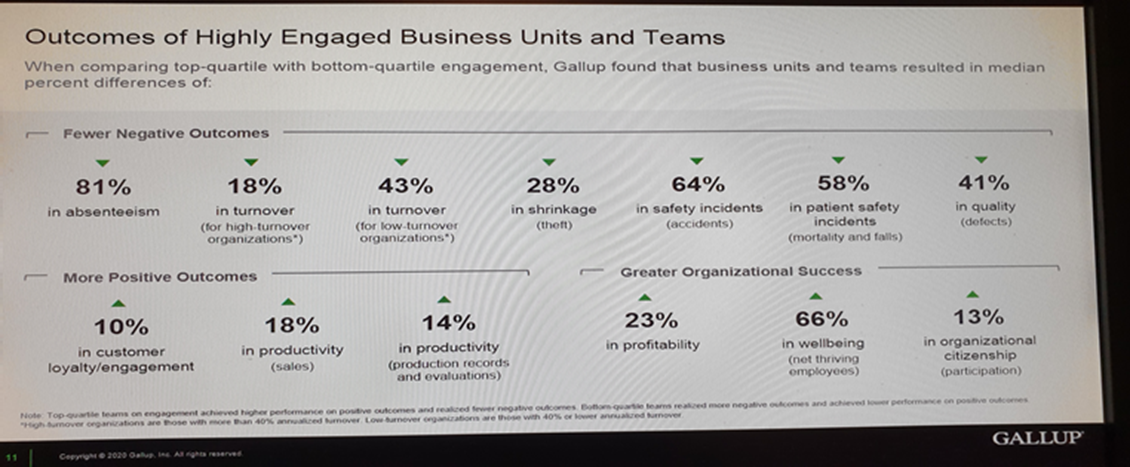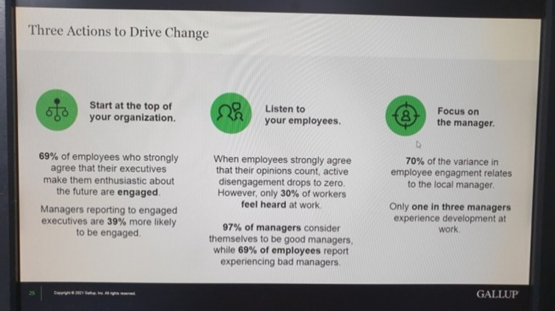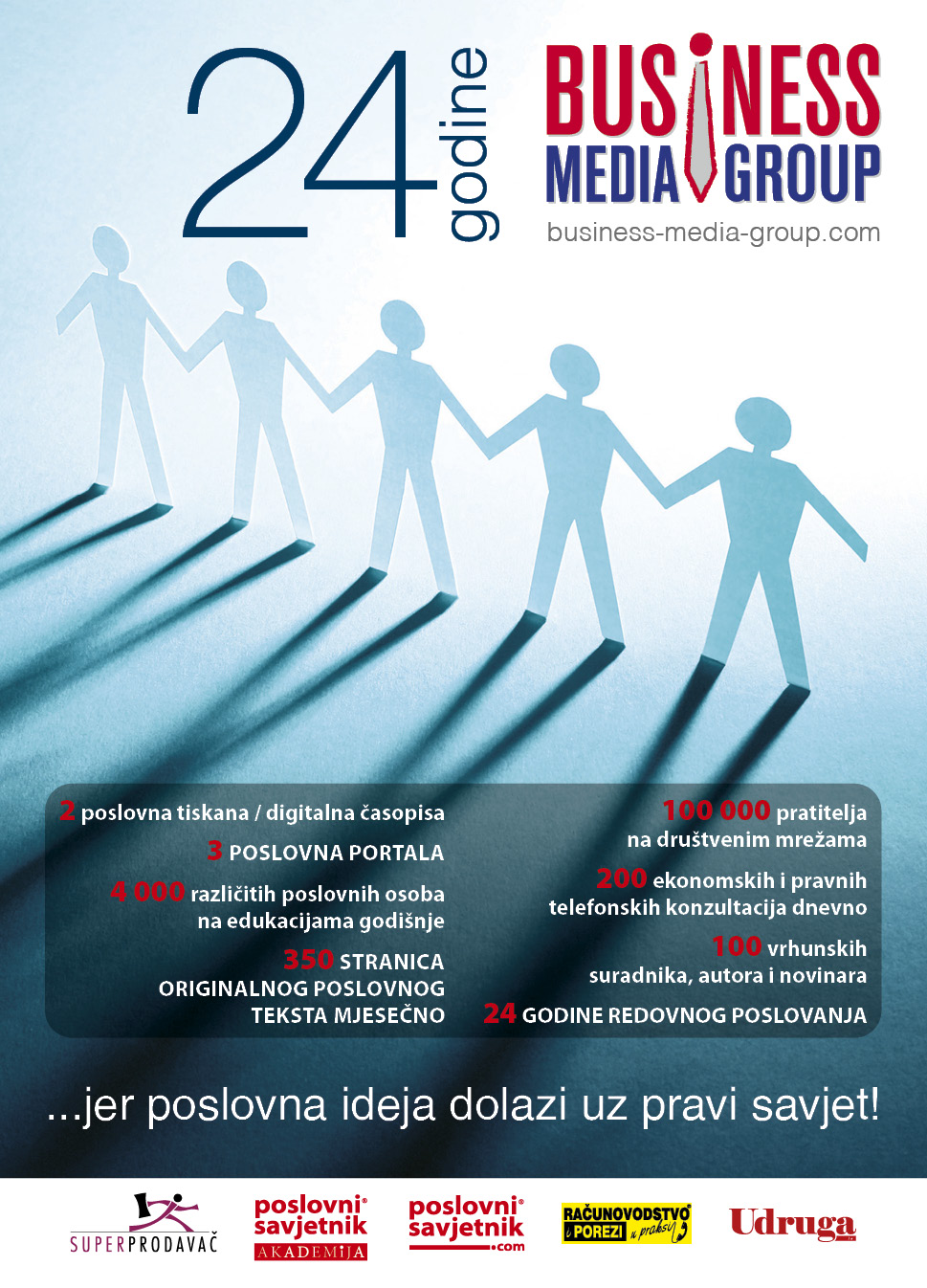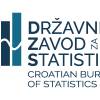John Lodder: How engaged and motivated are your people? How can you improve your workforce?

81,396 hours! That is how much of our life most of us spend working. *)
The only thing we spend more time doing is sleeping. If we spend so much of life at work, how is life at work going? According to the world’s workers: not well.
Gallup finds that 60% of people are emotionally detached at work and 19% are feeling miserable.
Is that a surprise? A shock? Or is it just a statistical explanation of the obvious?
The idea that “works sucks” is everywhere.
But workplace misery isn’t funny. Being miserable at work can bring more suffering to a person’s life than being unemployed.
Most countries around the globe are trying to find a new normal in many different ways, hoping the pandemic is over and new variants will not spike again. Do you remember that then, after (?) the Pandemic, we saw 47 million people quitting their jobs in mainly the western world? We named it ‘The Great Resignation’.
And three of the four main reasons for quitting their job were because of bad management.
In May 2022 Gallup presented its annual report of their global research about ‘Engagement and Wellbeing’.
I think these results are so important for organizations, their leaders and especially managers that in this column I summarize the global results, then dive deep into the results of Europe and Croatia. I end with a couple of conclusions and suggestions for improvement and some ‘leadership voices’ out their practice.
I think that every HRM-department should download the full report and check what it could mean for your organizational culture and your HR-policy. The link to this Gallup report is:
“Work” is “activity involving mental or physical effort, done in order to achieve a purpose or result.” (according to Oxford Languages)
Practicing mental or physical effort to achieve anything is rarely done without stress, worry or even pain.
Stress, anxiety and maybe a little pain will always be part of a high-performing job, but those negative emotions cannot be the very soul of someone’s job!
Yet, that is exactly the work-life experience for the 19% of workers who are actively disengaged.
-Ask them, “Did you feel stress yesterday?” 59% will say “yes.”
-Ask them, “Did you feel worried yesterday?” 56% will say “yes.”
-Ask them, “Did you feel physical pain a lot of the day yesterday?” 33% will say “yes.”
And, “How about anger?” 31% will say “yes.”
These figures are 46% to 83% higher than an engaged person would report.
Is there a Better Way?
The pain from work has caused leaders to invent new ways to get as far from work as possible.
Movements to attain a “work-life balance,” implement four-day workweeks and expand remote work are now everywhere. But it’s not just the hours, imbalance or location that leaves workers unhappy.
It’s what’s happening at work that makes them feel miserable!!
For example: balance is essential, but it implies a work/life separation. Emotionally compartmentalizing work, or anything in life, is hard. Even if your boss can’t call or email you after 5 p.m., you probably haven’t recovered from the berating he gave you earlier in the day. It’s almost impossible to leave that kind of emotional baggage at work.
In a Gallup study in Germany, 51% of actively disengaged workers said job stress caused them to behave poorly with loved ones.
So, what makes a bad job?
In one of the largest studies of burnout, Gallup found the biggest source was “unfair treatment at work.”
That was followed by an unmanageable workload, unclear communication from managers, lack of manager support and unreasonable time pressure.
These five causes have one thing in common: their boss. Get a bad boss and you’re almost guaranteed to hate your job. A bad boss will ignore you, disrespect you and never support you.
Environments like that can make anyone miserable. A manager’s effect on a workplace is so significant that Gallup can predict 70% of the variance in team engagement just by getting to know the boss.
*)
According to the Gallup World Poll, the average full-time worker spends 41.36 hours per week working.
If you assume people work 48 weeks per year, it means people spend 1,985.28 hours per year working.
Life expectancy is 73 and, according to the OECD, people retire at about 63. If people begin working at 22, then the average person works 41 years. Forty-one years of work at 1,985.28 hours per year is 81,396 total hours.
This estimate is conservative and may even be low; another estimate finds that people work over 115,000 hours in a lifetime.
Thriving at Work
Improving life at work isn’t rocket science, but the world is closer to colonizing Mars than it is to fixing the world’s broken workplaces.
Stakeholder capitalists think they have the solution. Using environmental, social and governance (ESG) metrics, they encourage companies to report on their impact on everything from the environment to their workforce.
But when it comes to the worker, most ESG reports focus solely on pay and demographics.
These are critical, but how do we know if workers are being treated with respect? Or feel cared about?
The real fix is simple: having better leaders in the workplace.
Managers need to become better listeners, coaches and collaborators.
Great Leaders help colleagues learn and grow, recognize their colleagues for doing great work, and make them truly feel respected and cared about.
In environments like this, workers thrive.
For 79% of workers, this kind of work environment may seem like a dream, but for 21% of workers, it’s a reality. They still have days with stress, worry and pain, but at half the rate as people who are actively disengaged at work.
In fact, 95% of people who are thriving at work report being treated with respect all day and 87% report smiling and laughing a lot.
Stakeholder capitalists would love the idea of more respect and care in the workplace, but will shareholder capitalists? “How does this impact the bottom line?” they ask. Tell them that it pays to have thriving workers.
Business units with engaged workers have 23% higher profit compared to business units with miserable workers. Additionally, teams with thriving workers see significantly lower absenteeism, turnover and accidents; they also see higher customer loyalty. The point is: Wellbeing at work isn’t at odds with anyone’s agenda.
Executives everywhere should want the world’s workers to thrive.
Helping the world’s workers thrive starts with seriously listening to them.
In 2021, global workers remained under the heavy burden of the COVID-19 pandemic. Although the development and delivery of effective vaccines offered hope that we were past the worst of the pandemic, more people died of COVID-19 in 2021 (3,5 million) than in 2020 (1,9 mio). Some regions saw signs of partial recovery, but others were significantly worse off than they were in the first year of the pandemic.
First the terminology and definitions explained
Understanding the Gallup definitions of (not) engaged, wellbeing etc. actually provides direct tools how to improve the engagement and wellbeing of your people. (I leave out the used metrics, formulas and explanations for other results; they are explained from page 166 of the Report.)
Employee Engagement
Employee engagement reflects the involvement and enthusiasm of employees in their work and workplace.
Gallup categorizes an organization’s employees as engaged, not engaged or actively disengaged.
Employees can become engaged when their basic needs are met and when they have a chance to contribute, a sense of belonging, and opportunities to learn and grow.
Engaged employees are highly involved in and enthusiastic about their work and workplace. They are psychological “owners,” drive performance and innovation, and move the organization forward.
Not engaged employees are psychologically unattached to their work and company. Because their engagement needs are not being fully met, they’re putting time, but not energy or passion, into their work.
Actively disengaged employees aren’t just unhappy at work, they are resentful that their needs aren’t being met and are acting out their unhappiness. Every day, these workers potentially undermine what their engaged coworkers accomplish.
Gallup Q12 Items
Gallup always asks 12 questions for their Annual Report. If you, or your HRM department, want to take positive actions for improvement, these questions could be developed into a powerful tool:
Q01. I know what is expected of me at work.
Q02. I have the materials and equipment I need to do my work right.
Q03. At work, I have the opportunity to do what I do best every day.
Q04. In the last seven days, I have received recognition or praise for doing good work.
Q05. My supervisor, or someone at work, seems to care about me as a person.
Q06. There is someone at work who encourages my development.
Q07. At work, my opinions seem to count.
Q08. The mission or purpose of my company makes me feel my job is important.
Q09. My associates or fellow employees are committed to doing quality work.
Q10. I have a best friend at work.
Q11. In the last six months, someone at work has talked to me about my progress.
Q12. This last year, I have had opportunities at work to learn and grow.
Environmental, Social, Governance
Environmental: Are you satisfied with your country’s effort to preserve the environment?
Social: We are not treated with respect all day on the previous day.
Governance: Corruption is widespread in their country’s business.
Job Market
Job Climate: It’s a good time to find a job.
Relocation Potential: I am likely to move.
Household Income: I am living comfortably on my present income.
6 main results of the Gallup Global Engagement and Wellbeing Research 2021
Gallup’s analysis of 112,312 business units in 96 countries found a strong link between engagement and performance outcomes, such as retention, productivity, safety and profitability.
Clearly, the COVID-19 pandemic put a halt to a long period of gradual but general improvement among the world’s workers. This matters for global economic dynamism. Gallup estimates that low engagement costs the global economy US$ 7.8 trillion and accounts for 11% of GDP globally. (What would it cost your company?)
1.Global employee vital signals in 2021: engagement and wellbeing remain stable but are not great.
- 33% of employees are thriving in their overall wellbeing. (32% in 2020)
- 21% of employees are engaged at work. (20% in 2020)
- Do employees find their work meaningful and rewarding?
- Do they think their lives are going well?
- Do they feel hopeful about the future?
The short answer is that most employees around the world would answer “no” to all three questions.
Prior to the pandemic, engagement was rising globally, but progress has stalled. Engagement rose by 1 percentage point in 2021, but remained below its 2019 peak of 22%.
Although global wellbeing also rose by 1 percentage point, this masks larger regional differences.
For example, the Australia and New Zealand region saw a 6-percentage-point increase in thriving in the past year, while Europe saw a 5-percentage-point decrease.
2.Stress among the world’s workers reached an all-time high - again.
In 2020 the world’s workers reached an all-time high for experiencing stress during a lot of the previous day.
In 2021, this percentage went even higher: 44% of employees experienced stress a lot of the previous day.
Those who agreed with this item may not have been stressed about work, but they were certainly stressed at work. Inevitably, how ‘stressed workers’ are feeling impacts the workplace. And while 2021 saw declines in worry, sadness and anger, all these negative emotions remained above pre-pandemic levels:
-Stress 44%
-Worry 40%
-Anger 23%
-Sadness 21%
3.Europe and South Asia were hit particularly hard in 2021 by COVID-19 waves.
Both South Asia (including India) and Europe dropped 5 percentage points in wellbeing in the past year.
South Asia had the lowest wellbeing in the world with 11% of employees that are thriving, the lowest regional wellbeing in the world.
When measuring wellbeing, Gallup asks respondents two questions:
1) How they rate their current life and 2) How they expect their life to be five years from now.
In South Asia and Europe, both these evaluations went down.
This means that not only did workers in these regions feel their current life was worse, but their hope for the future dropped as well. In addition, reported health problems increased by 4 percentage points in Europe.
4.The job market made a remarkable recovery in the USA and Canada region, but not elsewhere.
45% of employees said now is a good time to find a job, up slightly from last year, but less than the record 55% in 2019. The regional outlier for this item is the USA and Canada, which leads the world at 71%, up 44 percentage points from the previous year.
The next closest regions are Australia and New Zealand at 59% and South Asia at 50%.
5.For all its challenges, USA and Canada region remains the best region in the world to be an employee.
-No. 1 Employee Engagement
-No. 1 Job Opportunities
-No. 2 Wellbeing
-No. 2 Living Comfortably
Despite employees in the USA and Canada region being some of the most worried and stressed workers in the world, the region also has the most engaged employees.
Just over half of employees say they are “living comfortably” on their household income (vs. 22% globally) and the job market in 2021 in the USA and Canada region was exceptionally good, compared with the rest of the world.
6.Employee ‘wellbeing’ is the new workplace imperative.
Globally, employee engagement and wellbeing remain very low, and it’s holding back enormous growth potential. Engagement and wellbeing interact with each other in powerful ways.
We often think of engagement as something that happens at work and wellbeing as something that happens outside of work, but Gallup’s analysis suggests that’s a false dichotomy.
-How people experience work influences their lives outside of work. Employees who consistently experience high levels of burnout at work say their job makes it difficult to fulfill their family responsibilities. They are also 23% more likely to visit the emergency room.
-Overall wellbeing influences life at work. Employees who are engaged at work but not thriving have a 61% higher likelihood of ongoing burnout than those who are engaged and thriving.
When Gallup looks at our global workplace data through engagement and thriving combined, the results are striking:
-Stress Yesterday: 49% Not Thriving-Not Engaged 30% Thriving-Engaged
-Anger Yesterday: 24% Not Thriving-Not Engaged 11% Thriving-Engaged
-Health Problems: 16% Not Thriving-Not Engaged 8% Thriving-Engaged
When employees are engaged and thriving, they experience significantly less stress, anger and health problems. Nevertheless, globally only 9% of employees are in that thriving and engaged category, while the majority (57%) of the world’s employees are not engaged and not thriving.
Organizations need to think holistic: about the whole person, not just the worker
Leaders need to add wellbeing measurements to their executive dashboards. This can alert them to critical warning signs that do not show up on traditional spreadsheets.
They also need to prioritize employee wellbeing as part of their employer brand promise.
When leaders take responsibility for the wellbeing of their workers, the result is not only productive organizations, but thriving individuals, families and communities.
Global Results in numbers
Employee Engagement 21% Female 23% - Male 20% 40 years 20% ≥ 40 years 23%
Life Evaluation (Thriving) 33% Female 36% - Male 32% 40 years 33% ≥ 40 years 33%
Daily Negative emotions:
Daily Worry 40% Female 43% - Male 38% 40 years 40% ≥ 40 years 40%
Daily Stress 44% Female 47% - Male 42% 40 years 47% ≥ 40 years 39%
Daily Anger 21% Female 22% - Male 20% 40 years 22% ≥ 40 years 19%
Daily Sadness 23% Female 24% - Male 22% 40 years 23% ≥ 40 years 23%
Environmental, Social and Governance:
Environmental 61% Female 59% - Male 62% 40 years 61% ≥ 40 years 61%
Social 11% Female 10% - Male 11% 40 years 11% ≥ 40 years 11%
Governance 74% Female 74% - Male 74% 40 years 76% ≥ 40 years 72%
Job Market:
Job Climate 45% Female 44% - Male 47% 40 years 46% ≥ 40 years 45%
Relocation Potential 20% Female 19% - Male 21% 40 years 26% ≥ 40 years 13%
Household Income 22% Female 22% - Male 22% 40 years 21% ≥ 40 years 24%
Results for Europe
The Top Take Aways
-Lowest regional percentage of engaged employees
-Second lowest regional percentage of employees who say corruption is widespread in their country’s businesses
-Second lowest regional percentage of employees who say they are likely to move in the next 12 months
European Results in numbers
Employee Engagement 14% Female 14% - Male 13% 40 years 14% ≥ 40 years 13%
Life Evaluation (Thriving) 47% Female 48% - Male 47% 40 years 52% ≥ 40 years 43%
Daily Negative emotions:
Daily Worry 37% Female 39% - Male 35% 40 years 39% ≥ 40 years 35%
Daily Stress 39% Female 40% - Male 39% 40 years 42% ≥ 40 years 37%
Daily Anger 19% Female 20% - Male 18% 40 years 20% ≥ 40 years 18%
Daily Sadness 21% Female 22% - Male 21% 40 years 22% ≥ 40 years 21%
Environmental, Social and Governance:
Environmental 44% Female 42% - Male 45% 40 years 42% ≥ 40 years 45%
Social 8% Female 8% - Male 8% 40 years 8% ≥ 40 years 8%
Governance 60% Female 62% - Male 59% 40 years 58% ≥ 40 years 62%
Job Market:
Job Climate 44% Female 40% - Male 48% 40 years 45% ≥ 40 years 43%
Relocation Potential 14% Female 12% - Male 15% 40 years 20% ≥ 40 years 9%
Household Income 42% Female 42% - Male 42% 40 years 43% ≥ 40 years 41%
European Results per country
From 38 researched European countries I give you the top 3 and the last 3 of the total ranking, as well as Croatia’s score for comparison.
(The first % is the % of YES answers, between brackets is the average score of the last 3 years (+ or -).
Employee Engagement
1 Romania 33% engaged (+3) 2 Estonia 25% (+1) 3 North Macedonia 25% (+5)
20 Croatia 17% engaged (+5)
36 Luxembourg 8% engaged ( 0 ) 37 France 6% ( -1) 38 Italy 4% ( 0 )
Life Evaluation (Thriving)
1 Finland 84% thriving (-1) 2 Denmark 78% (-2) 3 Iceland 77% ( 0 )
28 Croatia 39% thriving (+9)
36 North Macedonia 28% (+4) 37 Bulgaria 27% (+2) 38 Northern Cyprus 18%
Daily Worry
1 Malta 66% (+2) 2 Portugal 60% (-3) 3 Montenegro 56% (+3)
4 Croatia 51% (-4)
36 Kosovo 25% (+1) 37 Lithuania 24% ( 0 ) 38 Switzerland 21% ( 0 )
Daily Stress
1 Greece 64% (-1) 2 Luxembourg 57% (+6) 3 Malta 53% (+4)
8 Croatia 45% (-8)
36 Estonia 38% (-3) 37 Latvia 24% (0) 38 Denmark 21% (0)
Daily Anger
1 Montenegro 39% (+1) 2 North Cyprus 33% (+3) 3 North Macedonia 31% (+2)
31 Croatia 12% (+1)
36 Iceland 8% (0) 37 Estonia 8% (+1) 38 Finland 5% (-1)
Daily Sadness
1 Northern Cyprus 28% (+1) 2 Italy 27% (-2) 3 Portugal 26% (-1)
31 Croatia 14% (0)
36 Iceland 12% (-1) 37 Hungary 12% (0) 38 Kosovo 6% (0)
Environmental
1 Finland 73% (+1) 2 Switzerland 70% (-3) 3 Luxembourg 69% (-6)
29 Croatia 36% (-2)
36 Italy 21% (0) 37 Romania 20% (-2) 38 Bosnia and Herzegovina 19% (-2)
Social
1 Northern Cyprus 16% (-1) 2 Lithuania 15% (-4) 3 Greece 14% (+1)
4 Croatia 12% (-5)
36 Iceland 4% (-1) 37 Norway 4% (+1) 38 Portugal 4% (-1)
Governance
Because of the sensitivity regarding corruption these numbers are not made available at country levels.
Job Climate
1 Denmark 69% (+1) 2 Lithuania 63% (+7) 3 Poland 62% (-3)
20 Croatia 47% (+3)
36 Spain 27% (-3) 37 North Cyprus 20% (-1) 38 Italy 18% (-1)
Relocation Potential
1 Kosovo 30% (-2) 2 Albania 25% (0) 3 Greece 22% (+1)
27 Croatia 11% (0)
36 Latvia 8% (+1) 37 Iceland 8% 38 North Cyprus (not enough data)
Conclusions
My general conclusion from this report is that the Croatian workforce is in a bad condition and that no relevant progress is made compared to the results of 2018, 2019 and 2020.
The low scores by employees give a clear indication about their experiencing and perceiving management behavior and of the toxic management culture in Croatian organizations in average.
Many possible and needed solutions come to my mind if I look at these numbers; also if I look at companies from my experiences as a customer of Croatian companies there are many improvements necessary.
Of course you may reject my conclusions completely, it’s a free world, however, as a manager or leader, you need to think about these numbers and draw your own conclusions about the state of your workforce.
And then, in honesty, do you think you should make some improvements for organization, for yourself, for your workforce and for your customers? Companies that took action booked results as seen in this overview: Figure 1.
Figure 1: Outcomes of Highly engaged Teams (figure 1 attached)

Which manager would not want results like a.o. a lower absenteeism? Lower thefts? Lower safety incidents? Lower quality defects etc.???
Which leader does not want results like a.o. happier and healthier people? Higher customer loyalty? Higher productivity? Higher profitability???
A few thoughts for actions to improve the Leadership Culture in your company
Business leaders have the power to greatly improve their employees’ everyday lives. Improving employee wellbeing ultimately depends on the decisions of executive leadership.
Leaders themselves must first be thriving and prioritize their managers’ wellbeing so that individual contributors see and follow others’ positive examples.
They must create policies that support the overall wellbeing of employees, both inside and outside the workplace. Ultimately, leaders must create a culture in which leaders, managers and employees weave wellbeing into their everyday conversations. Wellbeing must become a natural and expected part of “how we do things around here.”
Gallup's advice:
Gallup found that leaders who have a THRIVE Mindset report higher levels of organizational commitment, engagement and individual and group performance. These Leaders and their teams are more likely to report higher levels of inclusivity, psychological safety, and wellbeing.
Let’s be clear: it’s not that their THRIVE Mindset ensures everything goes perfectly. After all, these Leaders still work in the real world with all its unpredictability, uncertainty, disruptions and messiness.
It is that their THRIVE Mindset enables them to see the inevitable struggles every leader faces as an invitation to learning and growth rather than a sign that they are not up to their role. They understand that great leadership involves both thriving and struggle, and they have the confidence and courage to embrace both.
Accept the new will of the world. Gallup finds what the whole world wants is a good job.
This is especially true for millennials and even more so for Generation Z. They actually want to learn and grow.
The key is to address the "learn and grow" and announce that you are transforming your culture from administrating teams to coaching teams.
Another game-changer is to announce a change in the actual practice of Leadership within your organization and cancel all rating forms. Define your change exactly this way:
In this company we lead through a habit of having one meaningful coaching conversation per week with each team member!
This one coaching conversation per week can be in person, on the phone, email, Zoom, at coffee or standing in the hallway or elevator.
This is a highly researched finding, if you apply this it will immediately change your Leadership Culture.
Figure 2: Summary of three Leadership actions to successfully drive change. (Figure 2 attached)

A beautiful and inspirational thought by Steve Jobs, the brilliant Creator and Leader of Apple.
Poor leadership is building a great team and then doing everything in your power to hold onto control.
No one can develop and sustain a great company if no trust exists.
It makes no sense to recruit the best people and tie their hands by not giving them the freedom to perform.
Great leaders know that the soul of their business is their team and they must allow and trust their team to produce their very best work; that's why you recruited them in the first place!!
If you want to be a great leader give your team the space to work, create an environment free from micro-management, from the impediments of toxicity and then witness a significant growth of your company but, more importantly, of yourself, your team and your people. (source: Leadership First)
Leaders, by definition, have followers
It's natural to presume, therefore, that a main indicator of leadership success, for many the most important, is the number of followers. We see that dynamic played out with celebrity CEOs, social-media influencers, and thought leaders too; their worth and impact is based on how many people follow them.
But actually that's a huge mistake, because it conflates a byproduct of great leadership, lots of followers, with an objective of Great Leadership.
Leaders who view their position not from the perspective of their own ego but from the point of view of their company's greater purpose know that their single most important job is not to grow followers, it's to create leaders!
As GE's former CEO Jack Welch said, "Before you are a leader, success is all about growing yourself.
When you become a leader, success is all about growing others."
When you lead this way, you are rooted in the uplifting and connecting energy of people, you have the confidence and humility to know it's not just about you.
The bottom line is, great leaders create more great leaders. That's task one. Consider these questions:
-What do you believe is your most important job as a leader?
-Are you willing to make it a priority to develop other leaders?
-What might enable or get in the way of acting on that priority?
5 Essential Steps for Developing Great Leaders
1.Honestly assess your leadership beliefs. Ask yourself what might happen if you invest in growing other leaders. Note down any assumptions, fears, threats, and stories that might hold you back. Note also what propels you forward on this path.
2.Remember who helped you grow. Someone, maybe many people, supported your development as a leader. Make a list of what they offered that did and did not help you grow. By acknowledging these influences, you avoid unconsciously repeating any potential mistakes.
3.Make leadership development a key metric. Knowing we pay more attention to what is measured, develop simple and meaningful metrics of leadership development, both process and results. Bake these into every leader's responsibilities and accountabilities.
4.Get input all the way around. Go broad and ask everyone in your company what they would like in terms of leadership development and how their leadership growth would also benefit the company. Ask former and prospective employees too.
5.Build leadership development into your brand. Brainstorm with your team how leadership development is or can be a distinguishing aspect of who you are as a company. If growing leaders authentically fits your brand identity, integrate it into your recruitment, retention, training, and overall "people" strategy.
Realize and know that the people you help develop into powerful leaders will amplify your contributions to your company and industry, and may become the greatest legacy of your career.
The rise of Servant Leadership
I read an impressive article by Stacy Collett who interviewed several tech leaders who had to change their leadership style because their people suffered from the Pandemic. Just a few examples in summary.
The Great Resignation has ushered out the ‘command-and-control style leadership’ in favor of authenticity, integrity, empathy and empowerment.
Many tech leaders have been practicing at least some principles of servant leadership since the early 2000s when “authentic leadership” dominated as a management style. It focused on transparency and ethical leader behavior and encouraged the open sharing of information needed to make decisions and accepting followers’ input.
Servant leadership adds empathy and employee empowerment to that equation.
Servant leaders know how to build trust, provide the tools and support that employees need to grow, remove obstacles, listen more and talk less, and let employees create their own path for success. It can backfire though if employees aren’t dedicated to the team’s core mission. These tech leaders share how they practice servant leadership and how it creates value for their organization.
Blue Shield of California
CIO Nicole Raimundo Coughlin has always tried to look at her IT team holistically, listen to their needs, and provide them with opportunities to learn and grow. But the pandemic required her to take empathy and empowerment to a new level.
“Our Teams and Zoom meetings put us inside the lives of our employees in their homes,” says Coughlin. “It’s very different when someone tells you about their life and being able to see it. We were experiencing a front-row seat into the challenges and stressors that they were dealing with during the pandemic,” and it required greater empathy. She knew she needed to step up and really show employees that she cared about them and was willing to find new ways to support them.
Coughlin now considers herself a “servant leader,” a leadership style that prioritizes the growth, well-being, and empowerment of employees. It aims to foster an inclusive environment that enables everyone in the organization to thrive as their authentic self. Whereas traditional leadership focuses on the success of the company or organization, Servant Leadership puts People First to grow the organization through their commitment and engagement. When implemented correctly, servant leadership can help foster trust, accountability, growth, and inclusion in the workplace.
Proponents say that by improving the emotional health of employees, servant leadership empowers employees to express themselves more freely in the workplace. Employees then turn around and give the same nurturing to their coworkers, creating a welcoming environment that enables and encourages growth and quality work.
Rent-A-Center
Erik Sabadie was drawn to an IT leadership position at Rent-a-Center because one of the company’s core values, “acting with a servant’s heart,” closely aligned with his own spiritual journey. Sabadie leads with compassion and respect for his team members. “At our core, people want to feel loved, valued, and have a sense of belonging.
If those needs are being met at work, so many benefits will follow, for the company, the coworkers, and for me. Those reporting to me are much smarter and more capable than I am in their areas of responsibility; if I can simply remove obstacles, put them in positions to succeed, and be their champion when they need it, we will have unlocked so much more productivity than we could ever hope to accomplish on our own.”
Esprit de corps
David Reis started his servant leadership journey in 1994 in the Marine Corps, where he was taught that “leaders eat last. They first make sure their teams have the nourishment they need to be effective,” he recalls.
Years later while earning his bachelor’s degree in organizational dynamics; he learned that servant leadership means leading to serve rather than leading to be served.
“I discovered this was what I really experienced in my eight years in the Marine Corps,” he says.
As CIO of the University of Miami Healthcare System, Reis sees servant leadership as a way to create esprit de corps, get buy-in on direction, and help ensure that the service IT provides to stakeholders is as effective as it can be. “Servant leadership is about listening more and talking less,” he says.
Find out what employees need, whether it’s training, tools, or removing roadblocks. Reis holds monthly 8am coffee talks for all 300 IT staff. Attendance is voluntary and no topic is off limits. The meetings provide a safe space for team members to talk, it builds trust, and when Reis is able to remove an obstacle that his workers have identified, it reduces friction in getting work done. His leadership style resonates with employees and jobseekers.
Don’t mistake kindness for weakness
At times, servant leadership has gotten a bad rap because stakeholders think empathy and empowerment come at the expense of execution and results. IT leaders and consultants disagree.
“I don’t think it means giving up control or accountability, or letting people do whatever they want,” Dotlich says. “I don’t think it means that you do whatever [employees] ask either, which is how we normally think of ‘servants.’
But it is really facilitating people’s performance, goals, achievements, and aspirations. In that way you’re serving who they want to be or what they want to achieve.”
Blue Shield of California
Lisa Davis has practiced servant leadership for 20 years in positions in government, tech, and now healthcare as CIO of Blue Shield of California.
“I’m direct and honest in holding people accountable,” Davis says. “Of course it has to do with delivery of the messaging. Make sure people understand expectations and holding them accountable for delivering those results. How you engage with people is going to get the results.” Being available and approachable is key, she adds.
“You don’t need to wait to have a weekly one-on-one with me. If there’s something on your mind or you need help with, just text me.”
Ultimately, Davis is responsible for preparing her team leaders for the next roles they aspire to, and she expects those leaders to do the same with their own direct reports. “What happens at the top trickles down through the entire organization in terms of transparency, trust, collaboration, and supporting one another,” she says.
Give them direction and ‘turn them loose’
Tom Kuczynski has been practicing servant leadership principles for most of his 32 years of IT management, but he never gave it a label. Throughout his career he simply learned what worked and didn’t work and adapted his approach with every new opportunity.
“We hire very bright people to do a job and we let them do that job,” says Kuczynski, vice president of IT at the District of Columbia Water and Sewer Authority. “We give them a direction, and we point them in that direction and turn them lose to be as successful as they can. I need to be informed but I don’t need to be involved. I don’t want to be surprised by anything. I want to be available when you need assistance.”
Kuczynski’s leadership style not only empowers employees, but it also incentivizes them to stay with the public utility company. “We can’t afford to pay at the level of what some other organizations can pay, so you have to create an environment or culture that engages people and makes the job more attractive for other reasons,” he says, adding that he also focuses on the organization’s mission and purpose to deliver water to the community.
Empathy in practice
Providing empathy is often easier said than done.
Servant leaders admit that sometimes empathy and productivity demands are at odds when the pressure to produce is high. But there are several ways to lower the temperature.
“When you reach these periods of high pressure, sometimes we as leaders want to keep pushing forward.
But that’s exactly the wrong thing to do,” Reis says. “Sometimes it’s just better to take a minute, reframe, and then re-engage.”
Leaders can also show empathy with feedback, he says. “It would be easy to hear a list of complaints and for defensiveness to set in, which would be counterproductive,” Reis says.
“The empathy is in understanding that the issues being raised are part of the teammates’ sincere desire to make things better. You’re empathizing with that frustration and really hearing that. As leaders there’s a lot of processes that leaders don’t have to go through, so you don’t feel the same degree of intensity as those who have to go through those processes.”
Going forward, it’s important for each organization to define servant leadership “in a way that works in your own system, that people understand and that is not misleading, it’s not just a buzzword but is a philosophy of how we create an environment.”
These voices from the daily practice show that changing ones Leadership style cost a lot of energy but the profits are high, both for the Company, for the Leader in her/his role and for the employees and their wellbeing and development.
To end with an final reason why managers should improve Leadership traits and behavior in their organization.
The Future of Work
Ultimately, leaders must create a culture in which leaders, managers and employees weave wellbeing into their everyday conversations. Wellbeing must become a natural and expected part of “how we do things around here.” The global workplace is experiencing a generational shift in the way the world defines business success.
Going into the future businesses will not be measured by profits alone anymore.
They also will be measured by their positive impact on their people and our planet.
Organizations such as the World Economic Forum and the Big Four accounting firms are collaborating with each other and consulting with large organizations and regulators around the world to develop standard reporting for Environmental, Social and Governance issues.
Increasingly Governments are requiring these reporting’s from organizations in their countries.
Making the world better begins at work and you know what drives high engagement and wellbeing.
As you look ahead to the future of work in your country, I challenge you to reevaluate how you treat, train, coach and develop yourself and your employees to thrive in that future. The rewards are high for everyone.
For this column I was inspired by the Gallup ‘State of the Global Workplace 2022 Report, The voice of the world’s employees’, Dr. Moshe Engelberg and Stacy Collett.



























